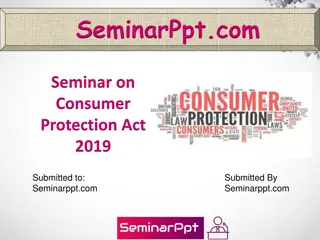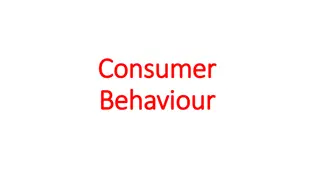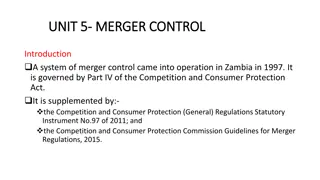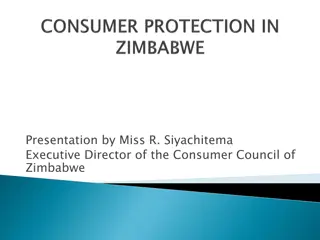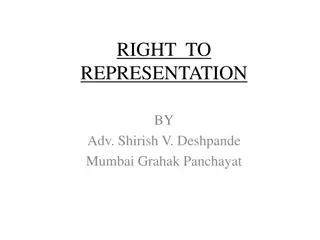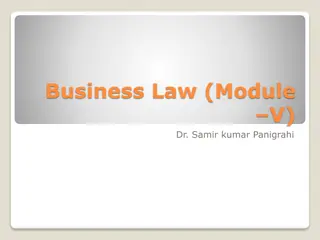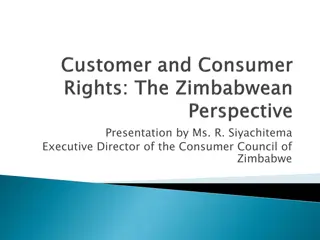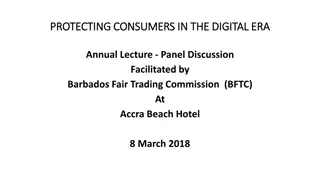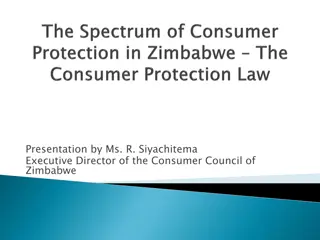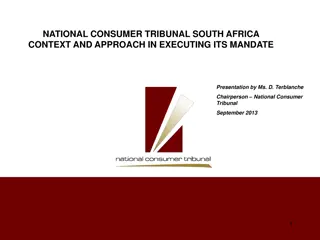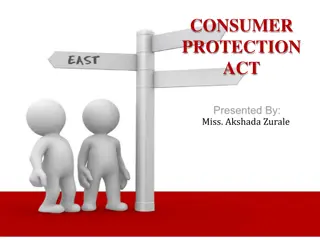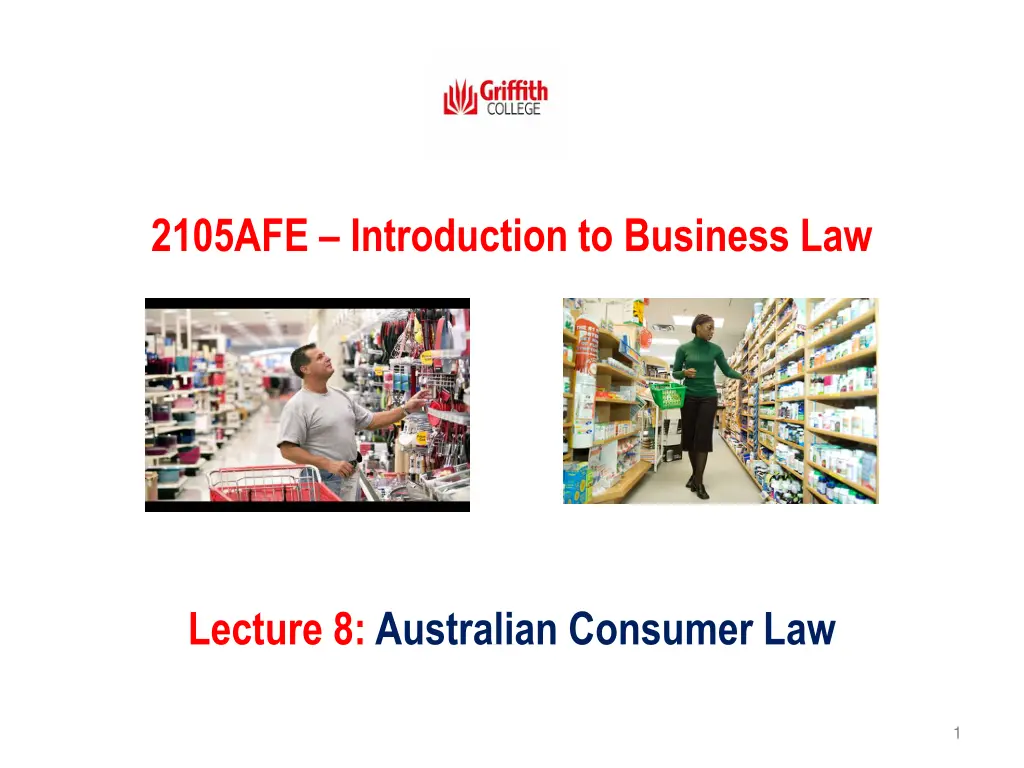
Understanding Australian Consumer Law: Key Aspects
Explore the Australian Consumer Law under the Competition and Consumer Act 2010, designed to safeguard consumers from unfair business practices. Learn about consumer protection laws, national product safety regulations, unfair contract terms, and more. Discover how various businesses, including banking, telecommunications, and travel services, are affected by these reforms.
Download Presentation

Please find below an Image/Link to download the presentation.
The content on the website is provided AS IS for your information and personal use only. It may not be sold, licensed, or shared on other websites without obtaining consent from the author. If you encounter any issues during the download, it is possible that the publisher has removed the file from their server.
You are allowed to download the files provided on this website for personal or commercial use, subject to the condition that they are used lawfully. All files are the property of their respective owners.
The content on the website is provided AS IS for your information and personal use only. It may not be sold, licensed, or shared on other websites without obtaining consent from the author.
E N D
Presentation Transcript
2105AFE Introduction to Business Law Lecture 8:Australian Consumer Law 1
Consumer Protection Law The Competition and Consumer Act 2010 (CCA) is a new national uniform law that provides for consumer protection. It was introduced in January 2011. The Australian Consumer Law ('ACL') is Schedule 2 of the Competition and Consumer Act 2010 The purpose of the Competition and Consumer Act 2010 is to protect consumers from unfair business practices. The Competition and Consumer Act (CCA) is an act of the Parliament of Australia and so it applies at both State and Federal level. https://www.youtube.com/watch?v=ze_nqcHylgk 2
The Competition and Consumer Act 2010 The CCA provides for: A national product safety regime An investigation and enforcement regime An unfair contract terms regime A regime for other unfair practices Prohibitions against specific types of unfair practices False or misleading representations New statutory consumer guarantees 3
The Competition and Consumer Act 2010 (cont.) Multiple pricing Lay-by agreements Country of origin claims Linked credit contracts Unsolicited supplies and selling practices Check out The Website: http://www.abc.net.au/tv/thecheckou t/clips/?play=checkout_01_03_returninggoods. mp4 4
The Competition and Consumer Act 2010 The Competition and Consumer Act 2010 is designed to protect you as a consumer in your dealings with business. S2 CCA - The object of the Act is to enhance the welfare of Australians through the promotion of competition and fair trading and provision for consumer protection. 5
Types of businesses affected by CCA reforms will include those who offer: Banking or financial services, loans, and credit card contracts; Software licences; Mobile phone and telecommunications contracts; Domestic building contracts; Many online sales (ebay, iTunes etc); Gym memberships; Utilities; Pay-TV subscriptions; Travel services; and Motor vehicles and/or services. 6
Who does the legislation apply to? In Australia, the Competition and Consumer Act 2010 (Cth) generally applies to the activities of corporations and to individuals in certain circumstances. Accordingly, the Act applies to: (1)The activities of corporations; (2)Commonwealth departments and statutory corporations; (3)Individuals (including sole traders, partnerships, and other unincorporated bodies) who: engage in interstate or overseas trade and commerce; use telephones or the mail; advertise on radio or television; trade with Commonwealth instrumentalities. 7
Who is the Consumer under the Competition and Consumer Act 2010? Definition: Consumer Section 3 ACL Consumer , in relation to an industry, means a person to whom goods or services are or may be supplied by participants in the industry 8
ACCC The Australian Competition and Consumer Commission (ACCC) The ACCC promotes competition and fair trade in the market place to benefit consumers, businesses and the community. It also regulates national infrastructure services. Its primary responsibility is to ensure that individuals and businesses comply with the Commonwealth competition, fair trading and consumer protection laws. For consumers The ACCC is a resource that provides information about your consumer rights or how to make a complaint? 9
ACCC For businesses The ACCC provides small business with support in regard to required standards of goods an services, franchising, mergers, authorisations, obligations, professions and industry codes of conduct 10
ACL Consumer Protection Provisions (1) Misleading and deceptive conduct: ss18-19 (2) Unconscionable conduct: ss20-22 (3) Unfair Terms: s24-25 (4) False Representation: s29 (5) Resale Price Maintenance: ss48 (6)Conditions and warranties- goods and services: ss54-56 (7) Liability of credit providers: s274 (8)Actions against manufacturers and importers for defective goods: ss138-150 (9) Product safety and product standards: ss106,122,123 11
Misleading or Deceptive Conduct s18 ACL (CCA) Definition: Misleading or deceptive: To lead into error Believe in something which is false To lead astray Misleading- to lead astray in action or conduct; to lead into error, to cause to err . Deceptive to deceive- to cause to believe what is false; 12
Misleading or Deceptive Conduct s18 Section 18 ACL (CCA): A person must not, in trade or commerce*, engage in conduct that is misleading or deceptive or is likely to mislead or deceive * trade or commerce: the conduct must have a trading or commercial character Case Example: eBay International AG v Creative Festival Entertainment Pty Ltd (2006) 13
What is Conduct? Puffs, opinions, literal truth, Silence, failure to disclose, or the giving of incomplete information can be misleading conduct. Example: Henjo Investments Pty Ltd. v Collins Marrickville Pty Ltd. (1988) Facts: Henjo agreed to sell a restaurant to Collins. The restaurant contained seating for 128 people. The terms of the licence for the restaurant limited seating capacity to 84 persons. Held: The court held that the Henjo Pty Ltd had a duty to disclose the details of the licence; it knew that the physical appearance of the restaurant gave a false impression and it should have corrected this. 14
Misleading or Deceptive Conduct s18 Whether conduct is misleading or deceptive or is likely to mislead or deceive depends upon 4 factors - Taco Company of Australia Inc v Taco Bell Pty Ltd (1982): Identify the relevant section (or sections) of the public (which may be the public at large) targeted by the conduct of the defendant. Determine the effect of the defendant s conduct on the relevant section or sections of the public, including the astute and the gullible, the intelligent and the not-so-intelligent, the well-educated as well as the poorly educated, men and women of various ages pursuing a variety of vocations . Decide whether the conduct was capable of being misleading or deceptive or likely to mislead or deceive the relevant section or sections of the public. **Note: **Only a small percentage of the relevant section of the public needs to be affected. Decide whether the conduct of the defendant caused the misconception. 15
Misleading or Deceptive Conduct s18 Conduct that causes confusion only will not necessarily amount to misleading and deceptive conduct. McWilliam s Wines Pty Ltd v McDonald s Pty Ltd (1980) Facts: McDonalds extensively advertised a hamburger under the name BigMac . McWilliam s a well-known wine company, started to advertise its wines using the words BigMac prominently displayed in the advertisements. McDonalds sought an injunction under s52 alleging that McWilliams use of words BigMac was conduct that was misleading or deceptive. Held: Not a breach of s18. Use of words BigMac may cause confusion as to whether there was a business connection between McWilliam s and McDonald s but such a person was not misled by the advertisement into believing that there was such a connection. Conduct which merely tends to cause confusion will not ordinarily be sufficient to constitute misleading or deceptive conduct under s18 16
Misleading or deceptive conduct s19 ACL (CCA) information providers ACL exempts certain information providers (including the news media), from the general prohibition of misleading or deceptive conduct: s19. However, the exemption does not extend to: statements made in an advertising context, s19(2) misleading statements made under a contract, arrangement or understanding with a person supplying goods or services of the type which was the subject of the publication: s19(3);Australian Competition and Consumer Commission v Channel Seven Brisbane Pty Ltd
UNCONSCIONABLE CONDUCT - s20-22 ACL (CCA) Section 20 of the CCA states that a corporation or a company shall not, in trade or commerce, engage in conduct that is unconscionable or unfair. The ACL (CCA) deals with various types of unconscionable conduct: S20 ACL (CCA) - General unconscionability within the meaning of the unwritten law s21 ACL (CCA) - More specific - Unconscionability in the supply of goods and services to another person or the acquisition of goods and services from a person s22 ACL (CCA) Matters the court may have regard to for determining breach of s21 18
What is an Unconscionable Conduct? Unconscionable conduct occurs when the stronger party in a transaction acts unfairly, usually by taking advantage of the other party s disability or disabilities. This is aimed at redressing the imbalance in bargaining power between sellers and buyers. So it incorporates greater protections for buyers. 19
Case Example: Commercial Bank of Australia Ltd v Amadio (1983) Facts: Two elderly parents of Italian origin (aged 76 and 71) Limited English. Persuaded by their son Vince and local bank branch (Vince a major customer thereof) to guarantee and mortgage their home to the bank as security for son s company bank loan. Parents believed liability limited to $50,000 for six months as son and bank did not disclose true position. In reality the liability was $240,000. Held:The mortgage and guarantee were set aside as unconscionable on basis would not have signed if they had known the state of the company s account and its insolvency. 20
The elements for establishing unconscionable conduct: Commercial Bank of Australia Ltd v Amadio 1. The weaker party was in a position of special disadvantage - special disadvantage includes poverty, sickness, age, sex, drunkenness, illiteracy, lack of education, emotional dependence. 2. The specialdisadvantage prohibited the weaker party from protecting him/herself 3. The stronger party knew of the specialdisadvantage and took advantage of the weaker party s special disadvantage. 4. The act of the defendant was unconscionable (unfair ,unjust) 21
**Vote Break**Unconscionable conduct Section 21(1) ACL (CCA): A person must not, in trade or commerce, in connection with the supply or possible supply of goods or services to another person, engage in conduct that is, in all the circumstances, unconscionable S22(1 &2) List of factors for determining breach of s21 not exhaustive Bargaining strengths of supplier and consumer Whether consumer required to comply with unnecessary conditions Whether consumer was able to understand any documents relating to the supply of goods & services 22
Unconscionable conduct S22(1 &2) List of factors for determining breach of s21 not exhaustive - Continued Whether undue influence or pressure exerted or unfair tactics used against the consumer The amount for which the consumer could have acquired identical or equivalent goods & services from a person other than the supplier Supplier s conduct consistent with its conduct towards other business consumers in similar transactions Compliance with industry codes (if any) Non-disclosure of any conduct that may affect the business consumer or add to its risks 23
Case Example: ACCC v Lux Pty Ltd (2004) Facts: The ACCC alleged that Lux Pty Ltd engaged in unconscionable conduct in relation to the door-to-door sale of a $945 Lux vacuum cleaner to a clearly vulnerable woman while she was home alone at her house in Port Pirie, South Australia. The vacuum cleaner salesman was overbearing, stood too close, spoke strongly, and wrongly made out that the consumer s existing vacuum cleaner was going to blowup . Held: The conduct was unconscionable because of the relative bargaining strengths of the parties; the consumer s limited capacity to understand the contract and the salesman s pressure. 24
Prohibition of unfair contract terms S 23 ACL (CCA) Unfair terms of consumer contracts (1) A term of a consumer contract is void if: (a) the term is unfair; and (b) the contract is a standard form contract. Consumer contract S 23(2): (a) a supply of goods or services; or (b) a sale or grant of an interest in land; to an individual whose acquisition of the goods, services or interest is wholly or predominantly for personal, domestic or household use or consumption. Consumer contracts are not for re-supply or for transforming them in trade or commerce in manufacture etc.
Prohibition of unfair contract terms S 24(1) ACL (CCA) unfair - A term of a consumer contract is unfair if: (a) it would cause a significant imbalance in the parties rights and obligations arising under the contract; and (b) it is not reasonably necessary in order to protect the legitimate interests of the party who would be advantaged by the term; and (c) it would cause detriment (whether financial or otherwise) to a party if it were to be applied or relied on. S24 (2&3) - Possible Defences for Person relying on Unfair Terms: (a) the extent to which the term is transparent; expressed in reasonably plain language; and legible; and presented clearly; and readily available to any party affected by the term. (b) the contract as a whole. 26
Examples of Unfair Terms S25(1) ACL (CCA) S25(1) lists examples of unfair terms in contracts the following are some examples from s25(1) A term that allows one party to avoid or limit performance of the contract, but not the other party; A term that allows one party to terminate the contract, but not the other party; A term that penalises one party for a breach or termination of the contract, but not the other party; A term that permits one party to change the characteristics of the goods or services to be supplied, or the interest in land to be sold or granted, under the contract, but not the other party; 27
False or Misleading Representations S29 ACL (CCA) S29(1) ACL (CCA) A person must not, in trade or commerce, in connection With the supply or possible supply of goods or services or in connection with the promotion by any means of the supply or use of goods or services. Examples: (a) & (b) that goods or services are of a particular standard, quality, value or grade (c) that goods are new (g) that goods or services have sponsorship, approval, performance characteristics, accessories, uses or benefits (i) with respect to the price of goods or services (j) concerning the availability of facilities for the repair of goods or of spare parts for goods (k) concerning the place of origin of goods (l) concerning the need for any goods or services (m) concerning the existence, exclusion or effect of any condition, warranty, guarantee, right or remedy 28
False or Misleading Representations Some Examples: A statements or representations about price in relation to range of goods and services may give a misleading impression of the price. Ascot Four Pty Ltd v ACCC (2009) Facts: A jeweller breached (s75AZ(1)(g) TPA) now s29(1)(i) CCA by displaying price tags on jewellery that showed the original price and then the reduced price, like this: Was $50!! Now $39!!! . The jewellery however had never been offered for sale at the higher price or even close to it. Price reduction must be real and genuinely less than the normal price, and should actually benefit the purchaser. 29
False or Misleading Representations Case Example: Hartnell v Sharp Corp (1975) Sharp advertised that their microwaves were of a specific quality and that they were tested and endorsed by the Standards Authority of Australia. The statement was completely false. HELD: The Full Court of the Australian Industrial Court held that Sharp had falsely represented that the goods were of a particular standard or quality when they were not and so was a breach of the TPA - now s29(a) and (b) ACL (CCA) 30
False and Misleading Representations - s29 Furniture and Bedding Concepts Ltd( FBC ) owns and operates Sleep City and Everyday Living Stores. In its 2008 Spring catalogue, FBC advertised bedding and furniture in the form of Now $X, save $Y . The save amounts were based on FBC s internally set recommended retail prices, not the prices which the products were offered, or sold, for a reasonable time immediately before the sale. 31
Resale Price Maintenance s48 ACL (CCA) S48CCA - A corporation or other person shall not engage in the practice of resale price maintenance. Resale price maintenance refers to a prohibition on manufacturers, importers and wholesalers not to force (coerce) retailers to sell, lease or hire goods or services for a specific price. The purpose of s48CCA is to protect consumers against unfair pricing and to enhance free market competition 32
Manufacturers liability for defective goods The basic premise of manufacturers liability for defective goods is that: Goods must be of acceptable quality s54(1) ACL (CCA) Goods must be fit for the disclosed purpose s55(1) ACL (CCA) Goods must correspond with the purpose s56(1) ACL (CCA) Note: The premise for manufacturer s liability does not include goods presented at auction 33
Manufacturers liability for defective goods Liability for non-compliance with the statutory guarantees of fitness for disclosed purpose - s55(1)and acceptable quality s54(1)does not depend on proof of negligence but on the existence of a contractual relationship between the parties. SeePt 3-2, ss51-56. Certain guarantees as to quality also apply in contracts for the supply of services to a consumer: ss60-61.
National product safety regime - ss106,122,123 Under the provisions of the CCA the Minister is now empowered to: Issue public warning notices about consumer goods or services require mandatory recalls of consumer goods impose interim or permanent bans on the supply of consumer goods or services make mandatory safety and information standards Require all supply chain participants to report goods or product related services that have caused or may have caused serious injury, illness or death, within 48 hours Apply threshold test for safety bans and recalls based on the concept of reasonably foreseeable of use and misuse of goods Conduct market surveillance powers 35
Other prohibited business conduct ACL also prohibits certain other kinds of business conduct in relation to the supply of goods and services: Offering rebates, gifts, prizes, or other free items with the intention of not providing them as offered Misleading conduct re nature of or manufacturing process of goods Misleading conduct re services Bait advertising Accepting payment without being able to supply as ordered Sending unsolicited credit /debit cards Misleading conduct : employment Assertion of right to payment for unsolicited goods or services Recipient not liable to pay for unsolicited goods or services Assertion of right to payment for unauthorised entries or ads Pyramid selling Pricing Referral selling Harassment and coercion
Guarantee relating to the supply of goods by description Bait Advertising S56 ACL (CCA) Section 56 ACL (CCA) bait advertising false advertisements intended to induce potential customers to go to a store, but there is no intention to supply the advertised goods at the advertised prices Example: False advertisements about the price of goods that are either priced more expensively or are not there at the store when customers arrive 37
Country of Origin Claims Goods labelled Made in Australia : ss255-257 ACL (CCA) Goods can only be labelled made in Australia if: More than 50% of the cost of their production was incurred in Australia; and They have been substantially transformed in Australia. Example: An offence would be committed under this provision if a product manufactured in a foreign country, but it was still labelled "Made in Australia". 38
Remedies Criminal Penalties - Criminal penalties are available under the ACL (CCA) for certain contraventions however preference is given to compensating victims Damages / Compensation: ss236, 237 Damages are a pecuniary compensation or indemnity, which may be recovered in the courts by any person who has suffered loss, detriment or injury, whether to his person, property, or rights, through the unlawful act or omission or negligence of another. Gates v City Mutual Life Assurance Society Ltd Damages may be compensatory or punitive according to whether they are awarded as the measure of actual loss suffered or as punishment for outrageous conduct. Note: $$ may be reduced if Court finds that the plaintiff is partly responsible for their loss 40
Remedies s224 Civil Pecuniary Penalty: Does not apply to misleading or deceptive conduct s151 Fines: Only applies to a breach of s29 in relation to false or misleading representation about goods and services s218 Court enforceable undertakings: If undertaking breached, Court can make any appropriate orders 41
Remedies s243 Other Orders: Includes, but is not limited to: Declaration that a contract is void Refusal to enforce some of the contract terms Variation of a contract Refund money or return property Repair of or provide parts for goods 42
Unfair practices: other enforcement provisions In addition to the criminal penalties and pecuniary penalties, the ACL provides the courts and the ACCC with the following enforcement measures Examples s246 and s247 corrective advertising substantiation notice public warning notice undertakings order disqualifying a person from managing corporations non-punitive orders adverse publicity order



